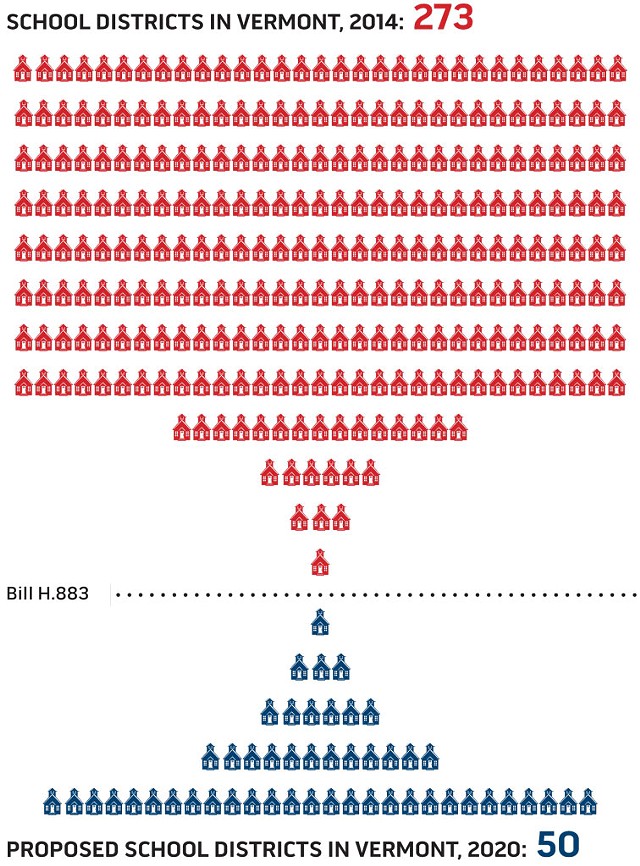Published April 2, 2014 at 10:00 a.m.
Rote memorization is out; personalized education is in. Textbooks are fading and iPads ascendant. But while education itself may have evolved greatly in Vermont since the 19th century, the state's system of governing its schools — a patchwork of small, mostly town-by-town school boards — has remained largely unchanged.
The state could be in for a shake-up, however, if legislation passed by the House education committee late last month gains traction in the final weeks of a busy legislative session. Lawmakers are pushing a bill to slash the number of school districts in Vermont from 273 to roughly 50 in the next six years.
The bill, H.883, could radically reshape the way schools are governed in Vermont. Instead of hashing out details of local school budgets in their own forums on Town Meeting Day, towns would band together in K-12 districts with an average 1,250 students each.
"It's very difficult to break that mold with how we've been doing things at the local level," acknowledged Rep. Peter Peltz (D-Woodbury), a staunch supporter of the bill who helped committee chair Rep. Johannah Donovan (D-Burlington) shepherd the legislation to a unanimous vote in committee.
Vermont has the smallest number of students per school district in the country — just 313 on average, less than 10 percent of the national norm, according to a 2009 report to the legislature. Lawmakers have tried to provide financial incentives for school districts to consolidate voluntarily — most recently in 2010 — but only one group (the towns of Landgrove, Londonderry, Peru and Weston) took the bait. The incentives included reductions in property-tax rates for four years following a merger, as well as a provision that would allow new districts to keep the proceeds from closing or selling school buildings instead of refunding a percentage of the sale to the state.
The new push for mandatory consolidation has some advocates of local control sounding the alarm. But supporters counter that without restructuring Vermont's school governance system, communities might find themselves with fewer choices than ever before.
"Unless we change things ... local control is going to be, 'Are you going to cut your music program or are you going to cut your art program?'" said Dan French, the superintendent of the Bennington-Rutland Supervisory Union. "That's where we're heading if we don't do governance change."
The rhetoric on both sides of the issue couldn't differ more starkly. Proponents of consolidation say it's a necessary move to modernize Vermont's antiquated patchwork of small — and in some cases, tiny — school districts. Consolidation, they say, would offer more opportunities for students, particularly those in smaller rural schools. For instance, larger school districts could hire — and share — language, arts and music teachers, or explore the possibility of magnet programs.
"I think there is growing evidence that there's real inequality in terms of learning opportunities for students across the state," said French, "and you don't have to go to the Northeast Kingdom to see it. I can see it in my own schools."
The legislation also claims to cut costs by centralizing resources, a change that proponents say is crucial in a state where per-pupil expenditures consistently rank among the top five in the country.
"If this effort doesn't work, we're going to have to come back to it pretty soon because we're financially on the edge of a crisis," said French.
But opponents — or, perhaps more accurately, skeptics — say that district consolidation is simply the first step toward closing treasured community schools. They question whether centralizing administrative functions would save real money in the long run.
"When you have a choice between democracy or bureaucracy, I'm going to favor democracy," said Bill Mathis, a former superintendent who now serves as the managing director of the Colorado-based National Education Policy Center, which produces peer-reviewed research intended to inform education policy discussions. Mathis still lives in Vermont, and sits on the state board of education, which voted 6-1 last week on a motion supporting H.883; his was the lone voice of dissent.
Mathis sees the merits of consolidating some tasks; his former supervisory union, Rutland Northeast, centralized functions such as hot-lunch preparation, bookkeeping and transportation.
"There are places where you can get economies of scale," he said. "But that doesn't necessarily lead to disempowering the local people who care very much about their school."
Marty Strange, a Randolph resident and the former policy director of the Rural School and Community Trust, also opposes the push for fewer districts. He's watched states grapple with consolidation for 15 years.
"It always ends up being the case that consolidation is something that the politically strong force on the politically weak," he said.
The bill has support from the Vermont Superintendents Association. Last week, the Vermont School Boards Association decided not to take a position on the legislation, but it did hold a series of meetings around the state on the issue this spring. Steve Dale, who heads up the School Boards Association, said that the reactions varied widely.
"It's a challenging and sensitive conversation," said Dale. "It requires us to strike the balance between the best interests of our students and our taxpayers [and] balance that with our deep love of our very, very local democratic process ... We have to find a way through this that respects both."
Proponents of the bill hope that the framework they've sketched out does just that.
"This is not done with a decree in mind," said Peltz.
As written, the bill would allow communities to draw up their own larger, K-12 districts in the next two years. Towns that don't draw up their own districts would later be assigned to larger groups as part of a statewide plan.
The legislation still needs to make it through two House committees — Ways and Means and Appropriations — before heading on to a full vote in the House. If it makes it to the Senate, it will face the scrutiny of the Senate Education Committee — whose leader, Sen. Dick McCormack (D-Windsor), Peltz describes as "agnostic at best" on the issue.
"I think the entire committee is working hard ourselves at keeping an open mind," said McCormack. "But an open mind doesn't mean I'm completely neutral ... Like it or not, even if you're pro-consolidation, it is a profound disruption of the status quo. It's a very deep reworking of how we do things."
McCormack added that though he's often opted to deviate from tradition in Vermont, the "burden of proof is on those who want to change." He said there's the possibility his committee would kill the bill — "in which case we're the skunk at the garden party."
It wouldn't be the first time the legislature has mandated top-down consolidation. In the 19th century, Vermonters used the "common school" system, in which towns had multiple small schools, each operating as its own district. At its peak, this system served just under 100,000 learners and included 2,500 school districts — a dispersed governance structure that, according to a 2009 report from the Education Transformation Policy Commission to the legislature, made it difficult to ensure the quality and equity of public education.
In 1892, after more than two decades of trying to encourage voluntary consolidation among common schools, the legislature mandated it. In the years since, Vermont has added supervisory unions and union high schools and middle schools, but today's 273 school districts are largely unchanged from the system developed in the 1890s.
Only a few communities in Vermont have put school district consolidation to a vote in recent years — and in every case except one, the proposals have failed. Two of five towns blocked the consolidation of the Chittenden East union in 2011. Both Fletcher and Fairfax rejected a measure to join forces that year, too. The three towns in Orange Southwest Supervisory Union failed to consolidate when one town narrowly defeated the proposition. (Supervisory unions in Vermont consist of groups of as many as 16 individual school districts; there's little uniformity in how they operate, with some providing powerful central offices and others acting more as loose confederations of individual districts.)
In Addison Northwest Supervisory Union, communities have voted twice on the idea. Initially, in 2010, the communities approved the plan, which would have created a unified board with 12 seats, but then a recall vote in Addison stymied the measure. Longtime school board member Rob Hunt says that many in town regarded the supervisory union as "the evil empire."
The five communities voted again on the prospect in 2011; Addison got on board, but this time Vergennes voted against the plan, and without universal consent the plan fell apart.
"One of the things that I said at the time was, 'Look, we can either do it ourselves or wait for the state to tell us to do it,'" said Hunt. "And now the state is going to tell us to do it."
More By This Author
Speaking of...
-

Video: Visiting the Kellogg-Hubbard Library’s PoemCity in Montpelier During the Month of April
Apr 18, 2024 -

Q&A: Catching Up With the Champlain Valley Quilt Guild
Apr 10, 2024 -

Video: 'Stuck in Vermont' During the Eclipse
Apr 9, 2024 -

Slideshow: Scenes From the Total Solar Eclipse in Vermont
Apr 8, 2024 -

New Jersey Earthquake Is Felt in Vermont
Apr 5, 2024 - More »
Comments (2)
Showing 1-2 of 2
Comments are closed.
From 2014-2020, Seven Days allowed readers to comment on all stories posted on our website. While we've appreciated the suggestions and insights, right now Seven Days is prioritizing our core mission — producing high-quality, responsible local journalism — over moderating online debates between readers.
To criticize, correct or praise our reporting, please send us a letter to the editor or send us a tip. We’ll check it out and report the results.
Online comments may return when we have better tech tools for managing them. Thanks for reading.















































